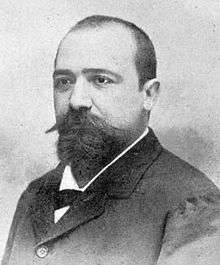Ernesto Cesàro
| Ernesto Cesàro | |
|---|---|
 | |
| Born |
March 12, 1859 Naples, Italy |
| Died |
September 12, 1906 (aged 47) Torre Annunziata, Italy |
| Nationality | Italian |
| Fields | Mathematics |
Ernesto Cesàro (March 12, 1859 – September 12, 1906) was an Italian mathematician who worked in the field of differential geometry. This is his most important contribution which he described in Lezione di geometria intrinseca (Naples, 1890). This work contains descriptions of curves which today are named after Cesàro.[1]
Cesàro was born in Naples. He is known also for his 'averaging' method for the summation of divergent series, known as the Cesàro mean.
Biography
After a rather disappointing academic career and a journey through Europe - which the most important stop was at Liege, where his older brother was teaching mineralogy at the local university - Ernesto Cesàro graduated from the University of Rome in 1887, while he was already part of the Royal Science Society of Belgium for his numerous works that he had already published.
The following year, he got a mathematics pulpit at the University of Palermo, which he kept until 1891. He settled in Rome, where he stayed as a professor at the Sapienza until his death, which occurred while he tried to rescue his youngest son Manlio from drowning.
Work
The main Cesàro's contributions belong to the field of differential geometry. Lessons of intrinsic geometry, written in 1894, explains in particular the construction of a fractal curve. After that, Cesàro also studied the "snowflake curve" of Koch, continuous but not differentiable in all its points.
Among its other remarkable works, the following are worth to cite : Introduction to the mathematical theory of infinitesimal calculus (1893), Algebraic analysis (1894), Elements of infinitesimal calculus (1897). He proposes a possible definition of a divergent sequence, known today as "Cesàro's sum", given by the limit of the mean of the sequence partial terms' sum.
Books by E. Cesàro
- Lezioni di geometria intrinseca (Naples, 1896) ISBN 1-4297-0344-X (trans. into German under the title Vorlesungen über natürliche Geometrie; 1901, 1st edn.; 1926, 2nd edn. trans. and with an appendix by Gerhard Kowalewski)[2]
- Elementi di calcolo infinitesimale con numerose applicazioni geometriche (L. Alvano, Naples, 1905) ISBN 1-4297-0178-1
- Corso di analisi algebrica con introduzione al calcolo infinitesimale (Bocca, Torino, 1894) ISBN 1-4297-0100-5
See also
- Stolz–Cesàro theorem
- Cesàro's theorem
- Cesàro equation
- Cesàro mean
- Cesàro summation
- Cesàro curve
- Lévy C curve
Notes
- ↑ http://www.tgmdev.be/curvecesaro.php
- ↑ Kasner, Edward (1930). "Review: Lezioni di geometria intrinseca trans. as Vorlesungen über natürliche Geometrie" (PDF). Bull. Amer. Math. Soc. 36 (1): 32. doi:10.1090/s0002-9904-1930-04873-9.
External links
- O'Connor, John J.; Robertson, Edmund F., "Ernesto Cesàro", MacTutor History of Mathematics archive, University of St Andrews.